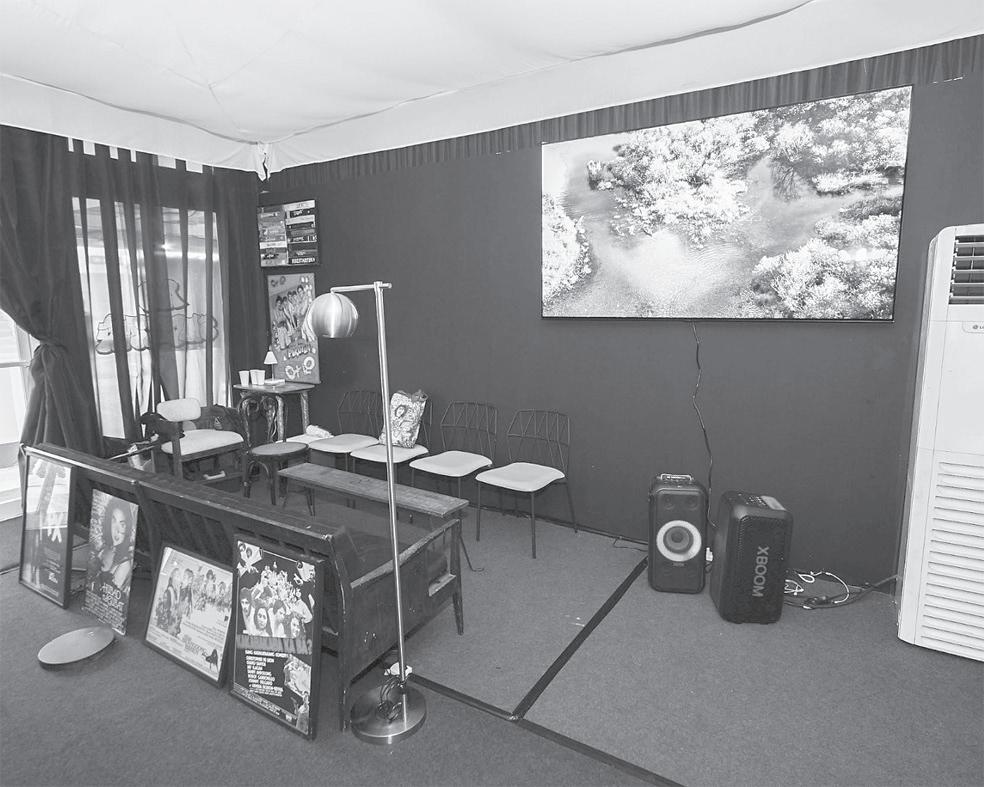






T“The









T“The

TWO years after the Kremlin’s invasion of Ukraine, many in Russia have reason to feel the wartime economy is working well for them in a setback for Western sanctions designed to pit the populace against the country’s leader, Vladimir Putin.
Wages have soared by double digits, the ruble has stabilized, and poverty and unemployment are at record lows.
For the country’s lowest earners—a key constituency for the Kremlin—salaries over the last three quarters have risen faster than for any other segment of society, clocking an annual growth rate of about 20 percent, Federal Statistics Service data show.
‘In good form’
AHEAD of Russia’s March 15-17 presidential elections, with Putin all but assured of winning a fifth term, public discontent over the economy largely isn’t there. Though the war has left hundreds of thousands killed or wounded, and longterm challenges continue to build with officials still wrestling inflation that is running ahead of their target, for now, the Russian leader is pointing to the economy and claiming success.
Russia is approaching the election “in good form,” said Sofya Donets, an economist at Renais-
sance Capital, pointing to “very optimistic” consumer sentiment and assessments of the current and future financial situation in surveys. “They already show a level that does not at all resemble a crisis.”
The government is spending massively on social support for families, pension increases, mortgage subsidies and compensation for the relatives of those serving in the military. The price tag for Putin’s pre-election promises may total tens of billions of dollars over the next six years.
The war on Ukraine has intensified an acute labor shortage as military recruitment draws workers out of the market, with Putin last month saying that employers had a deficit of 2.5 million people.
That has benefited ordinary Russians who as a consequence are enjoying security in their nearterm employment with managers reluctant to let anyone go. While the unemployment rate remains at a historic low, hiring expectations have soared to a record level, according to the central bank.

Rising commodity prices, rising income
A BIG and persistent source of economic worry for the Kremlin remains rapid price growth that eats into Russians’ incomes.
While that’s not fading, salaries are increasing faster, driven by massive government spending and the labor shortage. Average monthly wages in 2023 reached more than 74,000 rubles ($814), about 30 percent higher than two years ago.
Before last year, Russia had not seen an increase in real disposable income of more than 5 percent for many years.
“For a significant number of Russians, the war became an opportunity for social and economic mobility that was previously impossible. Some managed to launch a new business,” said Anna Kuleshova, a sociologist at the Social Foresight Group. “Some received payments for their husbands and sons at the front, which made it

The economy has started this year with similar momentum. January’s data on retail sales, real wages and industrial production came in better than the market forecast.
What Bloomberg Economics says:
possible to finally buy an apartment, a car, move from a village to a city.”
Putin boasts that unprecedented international sanctions have failed to derail the Russian economy, which has instead expanded, largely due to massive injections of money from the budget, military production and record trade with China.
Putin has cited data showing Russia breaking into the top five economies in the world in terms of purchasing power parity, after overtaking Germany, to back that up.
“THE government’s military spending spree is not free—it comes at a cost of reduced energy export revenue and dwindling foreign exchange reserves that Russia built up before the start of the war. In the short term, fiscal largess will continue to support high consumer confidence, but as Russia runs down the remains of its National Wealth Fund, the government will face difficult fiscal choices between accepting higher inflation, cutting spending or raising taxes.”
—Alex Isakov, Russia economist
The flip side of the coin is that the elevated social and war spending has resulted in a yawning budget gap and the threat that an already overheating economy might continue to drive up prices.
INFLATION remains above the
Bank of Russia’s target, even after it has significantly tightened
monetary policy, stifling credit activity in the country. Annual price growth accelerated in February to 7.7 percent from 7.4 percent in the previous month, despite policymakers’ hawkish efforts.
Meanwhile, this year’s federal budget gap was 1.5 trillion rubles by the end of February, while the Finance Ministry has planned for a deficit of 1.6 trillion rubles for the whole of 2024, and Russia’s available wealth fund reserves have been already halved.
The government, seeing the start of a new presidential term as a window of opportunity for unpopular reforms, is considering raising taxes on higher-income earners.
“The success story of 2023 is a story of recovery growth that will be difficult to repeat,” Donets said, adding that this year, fiscal stimulus should begin to taper as “the reserves that were the main source for it have already been largely used up.”
“Tax increases are inevitable, and quite large ones at that,” she said. Uncertainty remains the biggest challenge facing Russia’s economy and it “may cause us many more headaches,” she said.

require big spaces as they use some level of automation and robotics, according to Yu.
“So those kinds of industrial supply are considered to be premium grade already,” he added.
For him, what’s keeping the sector’s growth and stability this year are the ongoing massive infrastructure projects nationwide that are connecting Metro Manila to other provinces.
The top executive also highlighted the ongoing expansion of e-commerce, which has continued even after the pandemic. This growth is primarily fueled by the sustained preference for online shopping among individuals working in hybrid setups, such as those in the business process outsourcing (BPO) industry. Consequently, this trend will further increase the demand for warehouses and distribution hubs, making them significant consumers of industrial spaces.
“Now that we’ve seen that physical shopping, face-to-face, is fully enforced in malls, we still see a lot of online shopping. There was a 30 to 40 percent correction during the past two years, but it’s already stabilized. This is now the more organic demand,” he said. Manufacturing challenges WHILE there are enough industrial spaces waiting for them here, he noted that there remain challenges that turn them away from moving in to the Philippines.
“The biggest obstacles for the manufacturing sector is No. 1, electricity, [especially] for heavy manufacturing,” he emphasized, highlighting their heavy dependence on power that comes at a significantly higher cost compared to neighboring countries. “By just looking at the cost, it’s always turning them off.”
Yu cited, for instance, a global chipmaker that visited Subic and Bataan last year but opted to locate in Japan due to the low cost of electricity. “Our price in the Philippines is $0.16 per kilowatt hour,” he said of the power price here that is “20 to 30 percent” higher than other Southeast Asian countries. “We’ve lost a lot of business against Vietnam who’s charging the cheapest in the region at only $0.07 per kilowatt hour. Malaysia is $0.13, so it is still getting a lot of business. I think the $0.13 is already more or less an acceptable area. But if we can do better than that, of course, it will make us even more attractive.”
The second concern of potential industrial locators in the country, as in the case of Prime’s clients, is the regular updating of fiscal and non-fiscal incentives almost every five or six years in the country.
“This is also not too attractive for them because when they invest in heavy manufacturing, the returns are usually 10 to 25 years. So they need the sound and long-term stability when it comes to what type of incentives are they definitely going to get in the next 10 to 25 years, given the size of capital to build manufacturing buildings,” Yu explained.
The flexibility of Philippine labor policies is also an issue for most industries. Unlike in Vietnam, for example—wherein Prime’s customer shared that they can immediately shut down a temporary production area in less than one month—there are a lot of compliance moves that they need to carry out in the Philippines.
“Given the fast-changing environment around the globe right now when it comes to the use of AI [artificial intelligence] technology, many manufacturing companies are exploring a lot of on-demand and, at the same time, experimen-
tal production lines. And they want to be able to have the flexibility to open a new line and, immediately within six months to one year, they can just shut it down, without having too many compliances,” he pointed out.
Wake up the ‘sleeping giant’
DUE to the above-cited factors that hinder potential locators from investing to the Philippines, manufacturing is considered the “sleeping giant” in the industrial sector that needs to be awakened, Yu underscored.
“We have a lot of untapped market globally that we could have brought here in the Philippines,” said the founder and CEO of Prime Philippines. “If we revive the manufacturing sector, we’d make the Philippines more attractive for these global manufacturing powerhouses to locate their businesses here.”
Among the obstacles he mentioned, he believes that the government needs to consider subsidizing the electricity of heavy manufacturers within a short-term period to attract them to do business in the country.
“We cannot [entrust this solely] on the private sector. This is a government responsibility,” Yu said. Implementing such measures means continuous tax collection by the government as long as manufacturing remains here, benefiting not just the local economy but also the surrounding cities and provinces, Yu explained, referencing similar strategic moves made overseas, such as in Vietnam.
“So just by subsidizing the power cost, even if we have a high cost right now, having a policy to cover, or at least subsidize part of that, will already be a fast and quick approach to attract these companies,” Yu said.
Top PHL homebuilder Ayala Land targets the rich as high rates hammer middle class
Aapartments in December.
Since then, it’s sold about a fifth of its supply of 45 units across 45 floors, priced at $9 million each. Dy said that a $10 million unit in the future is “not impossible.”
These premium projects are targeted at customers earning P600,000 to P1 million ($10,829 to $18,049) a month, according to the company. That’s up to three times the country’s average annual household income of 307,000 pesos in 2021, based on the latest government data.
Luring shoppers back
DY said the company may spend around
P500 billion over the next five years to double its earnings, which rose 32 percent last year to P24.5 billion. For this year in particular, it has earmarked P100 billion in capital expenditures, up from P86 billion in 2023.
Ayala Land has also allotted P13 billion to redevelop four key shopping malls to reflect how shopping habits have changed since the pandemic.
“Consumers are more demanding,”
Dy said. “They’ve experienced e-commerce, and therefore if you want me back in the mall, you have to give me something more.”
Before becoming Ayala Land’s first female chief executive in October, Dy helped build the company’s land bank with increased acquisitions of idle lots that were transformed into mixed-use developments. When asked about plans for more land purchases, she said the company is focusing on using what they have.
While she is upbeat on the company’s prospects, Dy said there are also challenges ahead, including artificial intelligence. That could disrupt the call center industry, which are key tenants of Ayala Land’s office business.
There are also challenges in the middle-income residential market. Payment terms are being stretched as buyers cope with higher mortgage rates and inflation, she said, which increases the possibility of default. But a potential cut in interest rates could improve that segment and allow the company to shift its real estate offerings.
“We are keeping projects on pushbutton mode,” she said. “If the market turns, we’re ready to launch.” Bloomberg News

THE national government (NG) recorded a budget surplus of P88 billion in January this year, over 92.25 percent higher than the same month last year, as revenue collections outpaced government spending during the period.
Latest data from the Bureau of the Treasury (BTr) released on Friday showed that the budget surplus during the reference month was P42.2 billion higher than the P45.7 billion-recorded surplus in January of last year.
“The fiscal outturn was brought about by a faster 21.15 [percent] year-over-year [YoY] increase in revenue collection outpacing the 10.39 [percent] expansion in government spending,” the Treasury said.
The national government’s budget surplus in January was the highest in four years, or since the P86.872 billion recorded in April 2019, historical Treasury data showed.
Broken down, revenue collections for the first month of the year amounted to P421.8 billion, up by 21.15 percent, or P73.6 billion, from last year’s P348.2 billion.
This, as driven by higher tax collections, which comprised 91.31 percent or P385.2 billion of the total collection.
The remaining 8.69 percent or P36.6 billion was generated through non-tax sources, which declined
TO counter illegal drug smuggling by the sea, Philippine Coast Guard (PCG) commandant Admiral Ronnie Gil Gavan ordered the agency to beef up its maritime patrols to deter smugglers.
Gavan gave this directive after some P122.7 million worth of suspected cocaine were recovered in several vicinity waters and shorelines of Eastern Visayas and Northeastern Mindanao this month.
The PCG chief also directed Coast Guard Districts to heighten monitoring of vessels used in transporting illegal drugs, intensify intel operations, and expand coastal security patrols.
Aside from this, Gavan also instructed PCG personnel to coordinate their patrols with the Philippine Drug Enforcement Agency, Philippine National Police, and local
government units to augment anti-illegal drug operations, especially in the eastern seaboard of the Philippines. Coast Guard personnel have also been directed to strengthen local fisherfolk networks within their areas of responsibility for a more robust monitoring system, facilitating the accurate reporting of suspicious or unauthorized activities at sea. Attempts to sneak in illegal drugs via sea were first detected on March 1 when the PCG monitored the recovery of a suspected cocaine brick with an estimated weight of one kilogram and reportedly worth P5.3 million in vicinity waters off Barangay Bungtod, Tandag City, Surigao Del Sur. This was followed by another brick of suspected cocaine weighing around 1.08 kilogram valued at around P5.7 million that
Go’s Malasakit Team extends aid to patients, frontliners after PGH blaze in Manila City
IN the wake of a fire incident at the Philippine General Hospital (PGH) in Manila City on Wednesday, March 13, Senator Christopher “Bong” Go promptly dispatched his Malasakit Team to extend immediate support to the patients and frontliners affected through the provision of hot meals.
To comfort around 200 affected individuals in the hospital, the senator’s Malasakit Team organized a feeding program. They also served meals to some watchers and
hospital staff.
The fire erupted in the PGH Medicine Ward around 3 p.m. on the same day, which prompted hospital personnel to evacuate patients swiftly to ensure their safety. The Bureau of Fire Protection (BFP) immediately responded to the emergency call, deploying 13 fire trucks and an ambulance to the scene. Efforts to contain the blaze were successful, with the fire reaching a second alarm status by 3:11 p.m. but being placed under control by 3:45 p.m. The BFP later
was recovered by two fishermen near the same barangay on March 4.
On March 8, PCG personnel assisted in the recovery of 20 more bricks of suspected cocaine, initially spotted by a local fisherman off Barangay Tangbo, Arteche, Easter Samar.
“The estimated weight of the seized item is 25 kilograms, valued at P106 million,” Gavan said.
On the same day, a group of students also found a brick of suspected cocaine weighing 1.08 kilogram along the shoreline of Barangay Bitaug, Burgos, Surigao Del Norte.
The following day, the PCG recorded the recovery of several more suspected bricks of cocaine along the shoreline of Barangay Valencia, Lingig, Surigao Del Sur.
Rex Anthony Naval
announced that the fire had been fully extinguished by 4:30 p.m.
Meanwhile, in observance of Fire Prevention Month, Go emphasized the importance of preparedness and the necessity for the country’s fire safety measures to be continuously enhanced. He highlighted the relevance of Republic Act No. 11589, a legislative measure he primarily authored and co-sponsored.
This Act mandates a ten-year modernization program for the BFP, focusing on acquiring modern fire-fighting equipment, expanding the recruitment of firefighters, and offering specialized training to enhance their skills in emergency response.

by 8.68 percent YoY, the Treasury added.
The Bureau of Internal Revenue’s collection for January increased by 31.35 percent YoY to reach P308.4 billion from last year’s P234.8 billion.
“The improvement for the period was largely driven by the shift in VAT [value added tax] remittance from monthly to quarterly, pushing the crediting of [the fourth quarter] of 2023 collections over to January 2024,” said the Treasury.
On the other hand, the Bureau of Customs posted P73.4 billion in collections, exceeding the previous year’s outturn by 3.98 percent or P2.8 billion from P70.6 billion it collected.
Meanwhile, the Treasury’s income decreased to P16.7 billion, down by 5.73 percent or P3.5 billion, in January 2024 from last year’s P17.8 billion.
This, the Treasury explained, is due to lower income from interest on the national government’s deposits and investments, which was partially offset by the higher share from the Philippine Amusement and Gaming Corporation (Pagcor). Furthermore, revenue from other offices (other non-tax, including privatization proceeds and fees and charges) for the first month of the year also dropped to P19.9 billion, down by 11.02
percent or P2.5 billion from last year’s P22.4 billion.
Faster government spending was recorded in the first month of the year amounting to P271.6 billion, surging by 27.99 percent, or P59.4 billion, from last year’s P212.2 billion, attributed to reduced collections from the NG share from Malampaya proceeds.
Meanwhile, government expenditures in January accelerated to P333.9 billion, which rose by 10.39 percent or P31.4 billion from last year’s spending of P302.4 billion.
Primary expenditures, or expenditures net of interest payments for the month, amounted to P259.6 billion, which increased to 77.77 percent YoY from January 2023’s P255.4 billion.
Moreover, interest payments comprised the remaining 22.23 percent of the total expenditures for the month, which went up to P74.2 billion than last year’s share of P47 billion.
The Treasury noted that the 58.02 percent or P27.3 billion YoY increment in interest payments was due to the net effect of premia from last year’s reissuance of Treasury bonds from Global bonds issued in the same period.
Interest payments comprised 22.23 percent of the total expenditures for the month, higher than last year’s share of 15.53 percent. Interest payments as a percentage
of total revenues also increased to 17.60 percent from 13.49 percent a year ago. The government net of interest payments, meanwhile, registered a primary surplus of P162.2 billion for the month, growing by 74.91 percent or P69.5 billion from P92.7 billion the previous year.
Rizal Commercial Banking Corp. Chief Economist Michael L. Ricafort told the BusinessMirror that the lower long-term interest rates/bond yields and stronger peso exchange rate reduced the debt servicing costs and helped narrow the budget deficit.
He noted that in the coming months, possible US Federal Reserve (Fed) rate cuts that could be matched locally amid intensified tax collections and other tax/fiscal reform measures and easing inflation trend would help narrow further the budget deficit.
This, “in turn, temper the increase in the country’s debt stock and would help further ease the debt-to-GDP ratio to below the international threshold of 60 [percent] and help sustain the country’s favorable credit ratings of 1-3 notches above the minimum investment grade rating of the country,” Ricafort added.
In 2023, the Philippines’ budget deficit fell by 6.32 percent to P1.512 trillion, lower than the P1.614 trillion recorded in 2022.

THE country’s Balance of Payments (BOP) could settle at a “higher surplus” compared to initial projections, according to the Bangko Sentral ng Pilipinas (BSP).
Based on the latest outlook of the BSP, the BOP is expected to average 0.1 percent of the country’s GDP in 2024.
However, the expected increase in infrastructure investments could reverse the country’s BOP position in 2025 at a contraction of 0.1 percent of GDP.
“The BSP continues to emphasize limitations to the forecasts,
particularly given the continued buildup of external challenges. The BSP will continue to monitor closely emerging external sector developments and risks and how these may impact the BSP’s fulfillment of its price and financial stability objectives,” the BSP said.
The improvement in the BSP’s BOP outlook for 2024 was mainly




due to expectations that growth forecasts for the United States, China, and the Asean.
The improvement in the growth outlook for these countries could bode well for the country’s external trade performance.
Further, travel and tourism are still expected to improve to pre-pandemic levels given these better growth forecasts. BSP said this would improve the country’s services sector.
“These upward adjustments are mainly reflective of the stronger-than-expected growth outcome of these economies in 2023, as well as the role of fiscal policy support in the case of China,” BSP said.
However, world trade is still expected to be below its historical average. BSP said there is a potential increase in supply-side pressures due to weather and geopolitical shocks.
These shocks, BSP said, need to be closely monitored such as the conflict in Gaza and the attacks in the Red Sea. If these are left unresolved, the central bank said it could negatively impact external demand.
BSP said for 2025, the country’s overall BOP position will reverse to a deficit due to a wider tradein-goods gap as well a reduction in the projected financial account inflows.
“The larger shortfall in goods trade is primarily due to the faster increase in goods imports mainly on account of the strong growth in public infrastructure investments,” BSP said.
THE BSP said full year 2023 BOP position posted a surplus of $3.7 billion, a turnaround from the $7.3 billion deficit recorded in 2022.
With this, the country’s gross international reserves (GIR) amounted to $103.8 billion as of end-December 2023, higher than the $96.1 billion level registered as of end-December 2022.
“The BOP surplus was driven by the contraction of the current account deficit along with the expansion of the financial account net inflows,” BSP said.
In the fourth quarter, the country’s BOP position registered a surplus of $1.9 billion in the fourth quarter of 2023. This was more than three times the $568-million surplus recorded in the fourth quarter of 2022.
“The higher BOP surplus was supported by a significant increase in net inflows in the financial account. Meanwhile, the current account registered a higher deficit in the fourth quarter of 2023,” BSP said.
The data showed the country’s current account (CA) recorded a deficit of $11.2 billion in 2023, lower by 38.6 percent than the $18.3 billion deficit in 2022.
The BSP said the lower CA was due to a narrower trade in goods deficit. There was an increase in trade in services and secondary income accounts. The data showed that the estimated 91.5 percent of the drop in the imports value and 92.6 percent of the decrease in exports value were due to price changes.



DEPARTMENT of National Defense (DND) Secretary
Gilberto “Gibo” C. Teodoro Jr. on Thursday visited a naval detachment in Casiguran, Aurora highlighting ongoing efforts to beef up the country’s defensive capabilities in Northern Luzon.
This facility is under Naval Installations and Facilities-Northern Luzon and was completed in May 2022.
“The naval detachment, constructed and facilitated in cooperation with the Aurora Pacific Economic Zone and Freeport Authority [APECO], will boost the AFP’s [Armed Forces of the Philippines] presence in the area and enhance security in the Philippine Rise and Philippine Sea in line with the country’s Comprehensive Archipelagic Defense Concept [CADC],” DND spokesperson Arsenio “Popong” Andolong said.
Teodoro also met by Director Maria Cristina G. Suaverdez of the APECO Board of Directors, along with the officers of NIFNL, to discuss continuing efforts to guarantee the country’s control over the resources in the Philippine Rise.
The CADC, now being undertaken by the AFP, aims to protect
the country’s entire territory along with its exclusive economic zone (EEZ).
“In plain language, we are developing our capability to protect and secure our entire territory and EEZ in order to ensure that our people and all the generations of Filipinos to come shall freely reap and enjoy the bounties of the natural resources that are rightfully ours within our domain,” Teodoro said. He added that the CADC is a “strategic action” and will not need constant directives to carry out.
The DND chief earlier unveiled the CADC during a January forum with foreign journalists.
“I, thus, urge our commanders and units in the AFP to exert all efforts to operationalize the CADC,” Teodoro said. The DND said CADC seeks to secure the sovereignty of the state and integrity of the national territory as enshrined in the Philippine Constitution.
“As such, we are pursuing a CADC to address our vulnerabilities and enhance our capability to defend our national interest through certain long-term plans, which include upgrades in our facilities and deployment of personnel,” it added.



IN light of the recent legislation expanding cash gifts to individuals turning 80, 85, 90, and 95, a senior lawmaker on Thursday called upon local government executives to collaborate with the National Commission of Senior Citizens (NCSC) and other concerned agencies to swiftly complete the national database of elderly Filipinos entitled to the financial incentives.
Camarines Sur Rep. LRay Villafuerte emphasized the importance of accurately cataloging Filipino citizens aged 60 and above. He stressed that this comprehensive database is vital following the enactment of Republic Act No. 11982, granting a P10,000 cash reward to Filipinos at the ages of 80, 85, 90, and 95. Additionally, he highlighted RA 11916, an amendatory law increasing the Social Pension of Indigent Senior Citizens to P1,000.
RA 11982, also known as the “Act granting Benefits to Filipino Octogenarians and Nonagenarians,” amended RA 10868, or the “Centenarians Act” of 2016, by providing a P10,000 cash gift to seniors aged 80
HE
Twho are born in Batac are given additional P20,000 while those who were not born but are living in the Ilocos Norte city will get P15,000.
In February alone, a total of 30 nonagenarians (aged 90-99) and a centenarian identified as Remedios Bongay Tapac from Barangay San Julian received their cash incentives through house-to-house awarding by personnel from the City Social Welfare and Development Office (CSWDO), the Senior Citizens Affairs, and other city officials.
Through the Expanded Batac
The city government also gives gratuity in perpetuity in the amount of P10,000 to a centenarian on his/her 101st birth anniversary and every year thereafter until death.
“Their twilight years deserve much care, attention and financial assistance to tide them over with the increasing costs of necessities of their everyday life, especially medicines. As the saying goes, it’s better to give to the living than to the dead,” said Batac Councilor Violeta Daradar-Nalupta, who authored
and every five years thereafter until they turn 95.
RA 10868 provided for a P100,000 gift for seniors when they reach 100 years of age, along with a felicitation letter from the President.
Villafuerte explained that RA 11982 tasks the NCSC, in coordination with LGUs, the Departments of Social Welfare and Development (DSWD), Information and Communications Technology (DICT), and the Philippine Statistics Authority (PSA), to undertake an online registration of intended beneficiaries for the Elderly Data Management System. He urged LGU executives to assist in signing up all individuals aged 60 and above in their respective locali-

TIME is a great leveler. After it’s done with us, we all become ugh-ly and wrinkled, just like the once juicy fruit I placed in the ref two months ago and then forgot all about it. This is why being alive at age 60 or 70 is a good thing. You have the perspective to compare the “then” and “now.”
The other day, as my wife and I were reminiscing about our younger days, she couldn’t believe that the classmates and friends she used to admire and envy because of their good looks are now looking...well…so different, to be kind about it. As she scans the photos of her former high school crushes on Facebook, she is aghast to see them all pathetic looking. “Losyang” and “pendeho” were a few of the cruel words I heard her utter, with a slight hint of disappointment in her tone.
Looking at me, she said that at least I have remained looking the same all these years—ordinary looking. Ouch! But without skipping a beat, she rejoined that she cared more for the handsome person inside me. Was she just ribbing me? Are you familiar with that app that enables you to look young again? Narcissists and vain people love to use it on their photos and then enjoy posting the manipulated images.
 Camarines sur rep. Lray Villafuerte
Camarines sur rep. Lray Villafuerte
ties. This collaborative effort aims to ensure a comprehensive and accurate database of seniors entitled to cash rewards and those qualified for the indigents’ pension, raised to P1,000 per month.
Villafuerte expressed support for tapping unprogrammed funds or savings by the Department of Budget and Management (DBM) to provide the P10,000 cash gifts to qualified seniors promptly. The DBM’s release of the higher monthly pension for indigent elderly Filipinos in January 2024 was made possible by the 100 percent increase in the senior citizens’ pension fund from P25 billion to P49.8 billion in the 2024 General Appropriations Act.
“Seldom do Filipinos reach the age of 100, so what better way for the national government and Congress to show our country’s appreciation for the significant contributions of our grandparents and other seniors to society during their relatively more productive years than to give them
a cash windfall not only when they become centenarians but even when they turn 80, 85, 90, and 95 years old,” Villafuerte said. RA 11982 states that extra funding for the cash rewards for octogenarians and nonagenarians shall come from the annual General Appropriations Act (GAA).
NCSC Chairman Franklin Quijano sought the assistance of LGUs and senior citizens’ organizations in updating and completing the accurate database covering about 12.3 million Filipinos aged 60 and above, including their health profiles.
Villafuerte emphasized that a reliable database will aid the NCSC, with LGU officials’ help, in identifying all senior citizens, locating them, and ensuring they can avail themselves of the benefits due to the elderly.
The NCSC’s current database, culled from files of the PSA and Commission on Population and Development (Popcom), reportedly lacks complete information on the
country’s senior citizens.
Meanwhile, the NCSC on Monday proposed the creation of a centralized database system in place of the senior citizen’s purchase slip booklet for claiming discounts.
In a Bagong Pilipinas Ngayon briefing, Quijano said the booklets rarely serve their purpose as some senior citizens often forget to bring them when making purchases, preventing them from receiving discounts.
Quijano said instead of the physical booklets, a centralized database should be established to digitally record transactions regarding the senior citizens’ availment of not just medicines, but also basic necessities and prime commodities.
He said this would entail data sharing between merchants and the government.
“The substitute for the recording system is the mandate of the President that all government transactions should be digitalized and that means all the offices of government should work together, so that we will be able to set up a centralized database system,” Quijano said.
He also cited the impacts of paper on the environment as another reason to avoid using purchase slip booklets.
“If there are 12 million senior citizens, can you imagine how many trees will be cut? Paper comes from wood. So that is a practical reason I see to replace the booklets,” he said.
Quijano, however, stressed the need for Congress to amend Republic Act 9994 or the Expanded Senior
Citizens Act of 2010 to replace the booklets with a digitalized database.
“I hope that our Congress will also help us prepare. Of course, we are studying this and we are foreseeing that with the help of DICT, a centralized database will be made to address the issue,” he said.
As this developed, Department of Social Welfare and Development (DSWD) Secretary Rex Gatchalian has directed the agency’s Program Management Bureau (PMB) to make a study and recommendation regarding the senior citizen purchase slip booklet.
DSWD-PMB’s position paper dated February 1, 2024 recommended to Gatchalian the abolition of the purchase slip booklet as a requirement for the purchase of medicines by senior citizens.
The DSWD-PMB recommended the adoption of digitized records for the senior citizens, “considering the mobility and tendency to forget to bring their booklets and even read their content, it is no longer convenient on the part of senior citizens to use purchase slip booklets.”
“With the fast-paced technology and innovations, it is recommended to adopt an established system for monitoring, storing, and reporting data towards an efficient, consistent, and uniform implementation of the law and provisions for the availment of medicines, basic necessities, and prime commodities, among others,” the PMB said in its position paper.
Filane Mikee Cervantes of PNA contributed to this report
By Nick TayagBut what I like is another app that lets you see how a young person would look like as an old man or woman. Try using that app on anyone you idolize for their beauty and see if you would still go crazy about their looks. Thanks to technology, you don’t have to live long to see
Sadly, physical beauty matters in our world. Beauty rules! Why do you think we still have so many beauty contests, not only for women but now even for men and LGBTQ members and even mature women and housewives? There’s even a deplorable beauty contest for adolescent nubile girls dressed up as adults!
Blame it on the unconscious bias that is ingrained in every one of us. Even in our own families, we are biased in favor of better-looking children or relatives. This is the inconvenient and uncomfortable fact. We don’t even have to do research on it.
Because our world remains highly fixated on outward appearances some couples opt for IVF, in-vitro fertilization, so they can choose the genes of their future child to make sure she or he would be born better looking and thus enjoy the inherent advantages of attractiveness in many areas of life. Based on my own personal experience and observation, those who are good-looking are generally treated better. It’s called beauty privilege.

the beautiful object of your fantasy transform into an abject-looking feeble old person. Instant killjoy. The old truism is really true, that nothing lasts, not even beauty. But still we put so much value on physical appeal and invest so much money and effort to make ourselves look attractive.
If there is the phenomenon of “ageism,” which is discrimination against old people in general, there is also “lookism,” which describes a practice where decisions are based on appearance. There is something called a “beauty premium” that exists across society. Our choices of hirees, friends, leaders, are made based upon how someone looks.
One psychologist explains: “Good looking men and women are generally regarded to be more talented, kind, honest and intelligent than
their less attractive counterparts.”
Of course in my experience, it’s not true at all. My more attractive classmates and workmates were mostly intelligence-challenged.
Is it the culture we are born into that makes us beauty-biased? Maybe the movies we grew up on have something to do with it. Or is this bias in our genes or wired into our brain?
Can we change our perception of beauty? Can we turn ugliness into beauty in the eyes of beholders?
In Italy there’s a freak event called “Festival of the Ugly” in which contestants vie for the title of “the ugliest person”. There’s an organization behind it. They hold elections every year for the officers. Apparently, there is a lot of camaraderie and belonging. It’s their counter answer to society’s cult of beauty.
Applause for the effort, but to me it’s a losing battle, futile and pathetic. For one, ugly women aren’t buying it.
If you belong to the few who have the gift of beauty as well as the rest of us who are ordinary looking and unattractive, listen to this old man who now has a vantage view of what happens to the good, the bad, the beautiful and the ugly when they reach a certain age.
In the end, it does not matter. Friends will flatter us by saying we haven’t aged a bit, that we’re still “gorgeous as ever” but the mirror won’t lie: wrinkled, hair thinning, and facial muscles sagging.
The message is clear: from age 60 and on, we need to stop all efforts to delude ourselves into thinking that we are still attractive and desirable. The much-vaunted beauty privilege during your younger years can no longer give you an edge. It has lost its value, having depreciated year after year, as you advance in age. Even for the fairest woman and handsomest of men, this privilege can take you only so far.
The cult of beauty and worshipping at its altar have robbed us of
the very capacity for joy and wonder that makes life really worth living. Instead of investing money and effort on the external concerns of aging such as aesthetic surgeries and visits to beauty salons or stem cell treatments, it’s better to spend it on “the art of soulful aging,” a term coined by Thomas Moore, the spirituality writer of the book “Care of the Soul.” One point Moore strongly makes is that we age best by cultivating a rich inner life. It means seeking out what serves to uplift and enrich your spirit. Find them, hold on to them, and spend the rest of your life enjoying them. Not only will you feel better about yourself, you’re helping to enhance your personal inner growth. This is why I love spending time with the small circle of senior friends I now have. We have made peace with our looks. We can afford to laugh at our physical imperfections. We are not self-conscious anymore. We point to our white, thinning hair and our “kulubot sa mukha” and do not hesitate to agree and say “me too.”
So the talk is now more about activities that relate to our inner life. One of us has decided to be a lay minister in his local parish. One friend has rediscovered his yen for oil painting, while another has picked up digital photography to occupy himself. I enjoy a lively conversation with a kindred spirit reveling in our mutual enjoyment of books, music and films. Mostly our talks are about healthy pleasures that satisfy our deeper needs. I guess this tips the balance towards the other way. After all, the first half of our lives have been spent pursuing our obsession with externals that never last.
In the end, this is how I like old folks like me to fade away, with a face and body that’s no longer beautiful but with something more fulfilling: a beautiful life well and roundly lived.



AUNITED States government initiative will give Burmese youth the chance to pursue quality higher education in several Asian countries, including the Philippines.
The United States Agency for International Development (USAID) launched on February 29 the five-year, $45-million Diversity and Inclusion Scholarship Program that will provide
With the program, USAID is partnering closely with the Commission on Higher Education (CHED) to stream -
Tline the admissions process for Burmese learners and provide support services to facilitate their transition to studying in Philippine universities, including Batangas State University, Lyceum of the Philippines University-Batangas, St. Louis University in Baguio, the University of the Philippines-Diliman, and the University of the Philippines-Los Baños.
The Burmese scholars are expected to arrive in the Philippines by July 2024 to allow them to begin their

ASSISTANT Administrator Michael Schiffer
studies in the coming academic year.
“Through our partnership with USAID, [the commission] is honored to support Burmese youth in higher education,” said Chairman J. Prospero De Vera III DPA of CHED. “We continuously advocate for equitable, quality, and inclusive higher education, aiming to empower students from all backgrounds. Together, we’re

breaking barriers, building bridges, and driving transformative change through higher education.”
USAID’s Diversity and Inclusion Scholarship Program will provide quality educational opportunities for young community leaders in Burma, especially those from marginalized and vulnerable groups. It also offers grants to help Asian higher education institutions strengthen their capacity to support global students by boosting partnerships, growing regional networks, and expanding community service-oriented activities.
“This scholarship program is a strategic investment in higher education institutions in the region,” said USAID Assistant Administrator for Asia Michael Schiffer. “It recognizes our shared commitment to education as a catalyst for positive change in Burma and around the world.”
nity outreach and extension program entitled “CHEERS to Laudato si ’: Care for our common home through environmental expedition integrating the role of service-learning,” obtained second prize.
Respected academic individuals from the university were also recognized during the gathering, including Dean Emeritus Carmen Kanapi Ph.D who received the “Award for Service” posthumously.
Faculty of Pharmacy officials Prof.
Aleth Therese L. Dacanay Ph.D, Prof. Frieda Z. Hapan Ph.D, Prof. Edilberto P. Manahan Ph.D and Graduate School academic staff Prof. Belen L. Tangco Ph.D, OP were accorded service awards, while Prof. Lucila O. Bance Ph.D was named “Outstanding Accreditor.”
The
ONE of the leading private universities in the country, Far Eastern University (FEU) is an active partner of the women of the Municipality of Calatagan’s Brgy. Quilitisan in the province of Batangas in the production of “Amparo ”—a handmade soap showcasing beneficial cleansing action and local tropical scents.
Amparo is part of “Project Calatagan” —a capacity-building program of FEU’s Community Extension Services (CES) aimed at driving economic and agricultural sustainability, natural resources management, ecotourism, and various health-related, sociopolitical, and psycho-educational development programs.
The university’s CES endorses four variants of Amparo: Local Fusion, Earthy Floral, Summer Fresh, and Morning Fresh.
“Women of the community will be provided with a wage rate for every piece of Amparo soap produced,” said

Dr. Luzelle Anne Ormita who is CES’ director. “Since most of these partners are homemakers, this is an opportunity for them to have an alternative source of income without [leaving] their homes. We hope that this will be a step for them toward economic empowerment.”
Taking a research-based approach is a key component to FEU’s community extension projects. Rather than one-shot volunteer activities, the university focuses on creating longterm, sustainable impact anchored
on the United Nations’ Sustainable Development Goals (SDGs).
With Amparo, FEU aims to provide decent work and economic growth to the Brgy. Quilitisan community in adherence to SDG 8. Other projects for the community are the organization of the Quilitisan Cooperative and the area’s mushroom cultivation adhering to SDGs 2 and 15—all of which pave the path of building sustainable cities and communities (SDG 11).
Spearheaded by Jacqueline Marjorie Pereda who leads Project Calatagan, the production of Amparo involved a holistic approach that included training sessions, ongoing quality-control tools, and a commitment to continuous process improvement.
The product name “Amparo” was given by Graciel Lintag of the Academic Affairs Office, with respect to the first name of the spouse of FEU founder Nicanor Reyes Sr. Actual production began in November 2023. Head chemist Jim Cruz
formulated the soap in the FEU laboratory through a series of trials and consecutive consultations with various university departments.
The Spanish word amparo also means “refuge” or “shelter,” which is what the partnership project wishes to offer to the women of Calatagan.
“Our community partners were given hands-on workshops on safety and proper handling of chemicals as part of their training process,” said Pereda. “Their active participation gained them valuable skills that translate into income-generating opportunities, leaving a spirit of confidence and self-reliance.”
According to Precious Gonzales who is one of the soap-makers, the program has been a great help to them. Aside from the financial gain, she was able to expand her knowledge. Other local women also became more interested to learn not just about soap making, but also the other livelihood activities that they do together.
 Roderick L. Abad
Roderick L. Abad
By
TIMELY to the International Women’s Month celebration this March, Safer Campuses Ph called for revisions to the law that criminalizes gender-based sexual harassment in public areas, work places, schools and online amid recent reports about such happening in many campuses nationwide.
Since the enactment of the Safe Spaces Act (SSA), the newly launched coalition of student organizations and councils across the country has monitored at least 61 schools with campus predators, of which many are still employed in their institutions, or have transferred to others without facing administrative and criminal charges, enabling the possibility of committing the same offenses.
“We cannot wait for another victim before...legislators and education officials admit that they have failed to protect students,” stated Sophie Reyes who is the lead convenor of “Enough Is Enough”—a convening member of the coalition.
“It is distressing that instead of bringing about sweeping reforms in the education sector to stamp out campus predators and their enablers, the SSA has miserably failed to serve as a deterrent,” Reyes added.
The youth leader underscored that
instead of refining the policy that was ratified five years ago, last week’s hearings on the proposed charter change have centered on provisions about foreign ownership of the education sector.
“Now that officials are busy discussing the liberalization and foreign control of universities, gender justice seems to be farther than it was before…,” she said.
Last March 8, Safer Campuses Ph joined women’s organizations and progressive groups for the Women’s Day program in Mendiola, Manila to rally against the proposed Cha-cha.
Afterwards, they went to the Professional Regulation Commission Head Office in Sampaloc, Manila to deliver its position paper on the need to cancel professional licenses of campus predators and strip them of the authority to teach and work.
The coalition’s major demands regarding amendments to the law are mandating schools to provide psychological, legal, and financial support for victim-survivors; charging predators and enablers with criminal and administrative cases; revoking professional licenses and the blacklisting of campus predators; establishing a publicly-available national registry of sex offenders; and non-retaliatory policy to protect students from enabling school administrators.
FedEx empowers next generation via educational scholarship program for young women in STEM
ASUBSIDIARY of FedEx Corp. and one of the world’s largest express transportation firms, FedEx Express has renewed its ties with Zonta Club of Makati and Environs (Zonta) for two successive years to empower women in Science, Technology, Engineering and Mathematics (STEM) as part of the “FedEx Cares” program.
of local communities.




After a night in tallinn, I took the ship from the estonian capital to Helsinki, finland. The latter was another country close enough to add to my itinerary as I traveled around the Baltics and eastern europe.
It was a huge vessel with sleeping cabins, dining rooms with restaurants, and an entertainment room where passengers can drink and sing karaoke (and I thought the latter was a distinctly Filipino pastime). A few passengers hammed it up when they sang the chorus of their favorite song (Dancing Queen was one of them, another Filipino karaoke staple).
Others just enjoyed the show while snacking and drinking. As the ship lurched to dock, many of the passengers were eager to disembark. They queued in front of the exit even if it wasn’t open yet. I’ve read stories about Finns going on a day trip to Tallinn, just to buy cheap booze, groceries, or anything that was more expensive in Finland.


True enough, I saw people of all ages carrying boxes or bags of wine and beer, presumably to restock for a rainy day, a party or whatever ocassion. The ship took around 2+ hours to reach the Finnish capital from Tallinn, Estonia.
It was early in the evening on a cool spring day when I arrived at Helsinki. It was around 7-ish if my memory serves me right, but there was still enough daylight to see a bit of the city. I checked into my accommodation, dropped my bags, and went on my way to see Helsinki Cathedral. The latter is one of the most famous landmarks in the city. There were a few people walking around here and there. I heard a familiar language that immediately caight my attention.
Dali, pumwesto ka na diyan. Kunan kita ng picture. Pagkatapos mo ako naman .” I couldn’t help but smile
pUerto prinCesA redisCoVered new boutique resort puts spotlight back in palawan’s capital

Although a highly urbanized city that’s officially the capital of Palawan, Puerto Princesa has been considered, in recent years, as simply the gateway to Coron and El Nido, the archipelagic province’s now more popular tourist destinations. t hat’s about to change. l ately, I am particularly thrilled to see Puerto Princesa back in the spotlight, thanks in large part to the influx of more accommodation options that have in turn also highlighted the best places to visit in this wondrous city.
o ne of them is t he Funny l ion, regarded as the number 1 hotel chain in Palawan that opened its latest beachfront resort in Puerto Princesa only last December. t here are resorts and there are resorts. o ne of the things that I’ve observed in my recent travels is that getting to many resorts often involves lengthy trips by land and sometimes even by boat after landing at the airport. t hat’s not the case with t he Funny l ion. t he Puerto Princesa resort is only around 15 minutes away from Palawan International Airport, a plus for travelers who need to get a quick rest, freshen up, and enjoy
a good meal after a tiring flight. But t he Funny l ion is far from just a mere stopover. Booking a stay in t he Funny l ion is tantamount to experiencing an eventful staycation. For starters, I can’t get enough of its beachfront location which provides a tranquil and tropical landscape punctuated by virgin mangroves, coconut trees, and a stunning view of Sulu Sea. A swimming pool overlooks the beach, adding a relaxing option while savoring the scenery. t he Funny l ion boasts of 77 cozy and spacious rooms under three categories namely Cub, King, and Pride, obviously about the magnificent wild animal it’s named after. Even with its proximity to the city proper, never considered dining outside as t he Funny l ion’s dining options including its main restaurant, h unt already include a generous menu of Palawan cuisine as well as the resort’s take on other popular dishes. But as I mentioned, the best thing about t he Funny l ion for an urban traveler like myself is its proximity to the city proper. Not being secluded or isolated is a big part of its appeal not just for me but I can imagine for

other tourists as well because it does allow visitors to explore more of Puerto Princesa.
Depending on the desired time and preferred activity of guests, t he Funny l ion’s friendly staff can arrange tours of Puerto Princesa, Palawan’s u nderground River, u gong Rock Adventures, h onda Bay Island h opping.
Since our group was only staying at t he Funny l ion for a short time, we were able to take part in the city tour that allowed me to check out some of Puerto Princesa’s most sought-after tourist destinations for the very first time.
Mitra’s ranch
Al S o known as Rancho Mitra, the place is indeed owned by the family of the late h ouse of Representatives Speaker and former Senator Ramon Mitra. l ocated in Sta. Monica h eights and now open to the public, the once private
as I heard our kababayans take photos. I watched them for a while, one approached me and spoke to me in English. Then I responded to her in Filipino, and asked her to take my photo with the cathedral as the background. I thought to myself that this auspicious moment of familiarity bodes well for my brief visit in Helsinki.
My first stop on my first full day in Helsinki was Suomenlinna. The latter is a convenient attraction to visit because it’s accessible by a short ferry ride from the city. Suomenlinna or Sveaborg Fort dates to the 18th century and served as a deterrent to Russians who tried to access the Baltic. However, the Russians still managed to take the fort which they later strengthened and expanded. The Finns regained the fort after


they became an independent country in 1917. Suomenlinna Fort is now a UNESCO World Heritage Site. The huge complex reminded me a bit of Intramuros with its walls and canons. There were a few museums, restaurants, quaint houses, and historic building scattered in different parts of the island. After spending half a day in Suomenlinna, I felt it was time to return to the city and see more of it in the brief time I had. Desspite its small size, I discovered that Helsinki has quite a few architectural attention-grabbers, one of which is the Oodi Library. The latter’s mix of glass, steel, wood, and wave-like exterior caught my attention (even for someone with poor eyesight). The interior is just as impressive as the exterior with a café, quiet sections to read, event venues, studios, game rooms, urban workshop, and several books to


property and popular tourist destination includes the ancestral home of the province’s revered public servant, the highlight of which is a viewdeck with a breathtaking view of Puerto Princesa.
t he ancestral home itself is replete with photos and mementos that recall the Mitra family’s involvement in local and national politics. But in addition to the picturesque views and history lessons, the ranch also offers fun activities such as horseback riding, trampoline, and zip lining for the more adventurous types at very affordable rates.
Baker’s Hill
Although largely considered a premier pasalubong center in the city, Baker’s h ill is very much an Instagram-worthy tourist spot. Aside from the must-buy hopia, pastillas, and other baked goodies, the place doubles as a

choose from.
The Temppeliaukio Rock Church is another architectual gem with its combination of nature and manmade ingenuity. The church dates to the 1960s. Its designers Timo and Tuomo Suomalainen had its interior carved out of an ancient rock. Natural light rains down into the church, giving it an aura of serenity. Temppeliaukio is also a popular concert venue because of its acoustics. The Helsinki Railway Station is a throwback to the Art Nouveau design aesthtic with its sophisticated lines and curves. The two statues holding a globe each will grab your attention.
No one seems to be in a hurry in Helsinki (except me). The city and its residents go about at a steady pace. The cool climate, cafes, diverse choice of restaurants, and its many museums make it a destination you might consider adding to your itinerary.


park with several areas to have your photos taken including life-size colorful figures of pop culture icons like Marilyn Monroe, Shrek, Bugs Bunny and Donald Duck, just to name a few. l ove is also very much in the air in Baker’s h ill as the place is replete with signs full of hugot and pick-up lines like “the heart wants what it wants.” But even those who are not in a romantic mood will find a lot to like here. I couldn’t help but wax nostalgic here in Baker’s h ill as there were several moments when it reminded me of my childhood.
palawan Butterfly ecological Garden and tribal Village
A S the name suggests, it offers two things that at first glance seem to be an odd combination: butterflies and tribal culture. the first part features a wide array of colorful, free-
flying tropical butterflies originating from the Southern Philippines. Equally fascinating are the live exhibits of lizards, scorpions, and mantises, among others. But the place is not just a haven for insects but also doubles as a refuge for wild animals rescued from poachers including the Palawan Bearcat. t he second part, as the name of the place also suggests, is a tribal village populated by natives who demonstrate to tourists how things are done in indigenous communities like them in this province. t he villagers here, who talk in their dialect and even have their own alphabet, show how they hunt, play their native musical instruments, and yes, even how to start a fire using flint stones. All told, my recent visit to Puerto Princesa gave me a newfound appreciation of Palawan’s capital, thanks also in large part to my stay at t he Funny l ion. h ope to be back soon.






A8 Saturday, March 16, 2024
• Editor: Gerard S. Ramos
‘Exhuma’:







EXHUMA

THE Korean movie Exhuma is proof that having a good poster is important. I wanted to watch the movie (showing in cinemas on March 20) based off just looking at the poster. Lucky for me, Columbia Pictures Philippines invited me to an advanced screening of the movie and of course I said yes.
There will be no spoilers in this review. I will simply talk about what the movie is all about. Hwarim (Kim Go-eun) and Bong-gil (Lee Doh-yun) are two young shamans who are hired by a rich KoreanAmerican family to solve a supernatural-related problem. Hwa-rim early on realized that the problem is something related to the Korean family’s ancestors so she asks them to include Kim Sang-deok (Choi Minsik), a geomancer or feng shui expert, and Young-geun (Yoo Hai-jin), a mortician, to the team.
What happens next is a series of gruesome deaths and scary occurrences. This film is a thriller but there are barely any jump scares. What’s scary is the idea of bad spirits out there.
Filmmaker Jang Jae-hyun is the person behind Exhuma and like his previous films, this deals with religion, death, and the afterlife. His debut film The Priests and 12th Assistant Deacon were both about Catholicism and the supernatural.
Meanwhile, Svaha: The Sixth Finger is about a mysterious girl and a cult. It’s a religious-themed horror movie.
By the way, Exhuma surpassed 2 million moviegoers four days after the film opened in South Korea. This was the biggest Korean box office opening of 2024. The movie brought in almost 2 million moviegoers (1,963,564) in just one weekend (February 23 to 25).
The movie also eclipsed the box-office showing of Dune in Korea, despite the fact that the Hollywood movie’s stars went to Seoul to promote it.
According to data from Kobis, the tracking service operated by the Korean Film Council (Kofic), Exhuma has made $43.5 million total since its debut. This is the box-office record for 11 days of showing.
I would highly recommend Exhuma to fans of Korean cinema and those who enjoy the unraveling format of storytelling. The cinematography is good and eerie, and the acting is superb. Lee Do-hyun is a revelation here with his understated acting. Kim Goeun is perfect for her role while Choi Min-sik and Yoo Hai-jin turned in superb performances as usual.
What I like about Exhuma and many other Korean movies is the banter between the characters in between the more exciting scenes. It’s like they showing us that they’re normal people even when paranormal things are happening to them.
Overall, Exhuma is a highly recommended film about Korean shamanism. This is a topic that fascinates me so much.

I ATTENDED the the launch of Viral Records last October and I was impressed with the label’s commitment to promote its artists, all of whom were newly signed at that time. Most of the Viral Records artists were seasoned performers but some were newbies in the industry.
In news about Viral Records’ artists, Chandler and Top Notch have released new singles—“Bitin” and “Kape,” respectively.
“‘Bitin’ is written for those who want to tell the person they admire that they won’t be unsatisfied if given a chance at love,” said Lawrence of Top Notch.
In addition to the song’s message, Top Notch said listening to the “Bitin” could leave you wanting more—just like the title. This is because only a third of the song has words; the rest is instrumental.
But because of the power of music, even with few words, “Bitin” will take you back to the time when you were just falling in love with a person, and it’s all about kilig. The inspiration behind Chandler’s “Kape” is a classmate who loves coffee.
“My classmate and his girlfriend always go to
event types. Aside from standard tournaments, raffles, giveaways, onground community gatherings, and other activities may now be expected through the service.
Impact,” “Honkai: Star Rail,” “Ragnarok Origin,” and more. Through the expansion of its roster of games, Globe Gamer Grounds becomes positioned to organize a wider variety of community
“Together with Globe, we are committed to delivering enriching experiences that cater to the diverse interests of gamers. We encourage everyone to stay tuned to Globe Gamer Grounds for upcoming events and promotions,” said Ted Medalla,
coffee shops for their dates. You know, I really hope they continue staying strong because wouldn’t it be nice to have ‘Kape’ played during their wedding someday?” shared Chandler. The single opens with an invitation—“Tara, kape tayo”—and listening to it will make you say yes instantly. Paired with jazz elements, Chandler’s soothing voice will remind you that coffee is best consumed when shared with someone special Chandler and Top Notch are both committed to continuing making music, collaborating with other Viral Records artists, and practicing their live performance skills.
More specifically, Top Notch plans to get into EDM Rock and Alternative Pop genres, while Chandler wants to blend modern and traditional melodies and wordplays in future songs.
Meanwhile, Lirico has also released their latest single entitled “Ichibu,” which literally translates to “one part.” The collective releases of “Bitin,” “Kape,” and “Ichibu” highlights Viral Records’ commitment to championing local music and artists.
Follow Viral Records on Facebook and Instagram to know more about the activities of their artists. ■
www.businessmirror.com.ph

European regulators want to question Apple after it blocks Epic Games app storeBY KELVIN CHAN The Associated Press
LONDON—European Union regulators said they want to question Apple over accusations that it blocked video game company Epic Games from setting up its own app store, in a possible violation of digital rules that took effect in the 27-nation bloc on Thursday.
It’s a fresh escalation of the high-stakes battle between the two companies. Epic, maker of the popular game Fortnite, has spent years fighting Apple’s exclusive control over the distribution of iPhone apps.
Epic asserted on Wednesday that Apple thwarted its attempt to set up its own iOS app marketplace to compete with Apple’s App Store, calling it a breach of the EU’s new Digital Markets Act.
The sweeping set of rules, designed to stop big tech companies from cornering digital markets, have forced Apple to allow people in Europe to download iPhone apps from stores not operated by the US tech giant—a move it’s long resisted.
The European Commission, the EU’s top antitrust watchdog, said in a statement on Thursday that it has “requested further explanations on this from Apple under the DMA.”
The rules threaten penalties that could reach into the billions for violations.
Apple has already been hit this week with a $2 billion EU antitrust fine for thwarting music streaming competition.
The commission said it’s “also evaluating whether Apple’s actions raise doubts on their compliance” with other EU regulations including the Digital Services Act, a second set of regulations in the bloc’s digital rulebook that prohibit tech companies from ”arbitrary application” of their terms and conditions.
Epic contended that Apple was brazenly violating the DMA by rejecting an alternative iPhone app store that it planned to set up in Sweden to serve European Union users.
It accused Apple of retaliating for scathing critiques posted by CEO Tim Sweeney, who spearheaded a mostly unsuccessful antitrust case against the iPhone App Store in the US.
Apple said its action was justified because of Epic’s previous unlawful actions and litigation that resulted in the US court decision in 2021.
Apple ousted Epic from its App Store after it tried to get around restrictions that Apple says protect the security and privacy of iPhone users, while also helping recoup some of the investment that powers one of the world’s most ubiquitous devices.
“Epic’s egregious breach of its contractual obligations to Apple led courts to determine that Apple has the right to terminate ‘any or all of Epic Games’ wholly owned subsidiaries, affiliates, and/ or other entities under Epic Games’ control at any time and at Apple’s sole discretion,’” Apple said in a statement.
“In light of Epic’s past and ongoing behavior, Apple chose to exercise that right.”
LONDON—European Union lawmakers are set to give final approval to the 27-nation bloc’s artificial intelligence law Wednesday, putting the world-leading rules on track to take effect later this year.
Lawmakers in the European Parliament are poised to vote in favor of the Artificial Intelligence Act five years after they were first proposed. The AI Act is expected to act as a global signpost for other governments grappling with how to regulate the fastdeveloping technology.
“The AI Act has nudged the future of AI in a human-centric direction, in a direction where humans are in control of the technology and where it—the technology—helps us leverage new discoveries, economic growth, societal progress and unlock human potential,” said Dragos Tudorache, a Romanian lawmaker who was a co-leader of the Parliament negotiations on the draft law.
Big tech companies generally have supported the need to regulate AI while lobbying to ensure any rules work in their favor. OpenAI CEO Sam Altman caused a minor stir last year when he suggested the ChatGPT maker could pull out of Europe if it can’t comply with the AI Act—before backtracking to say there were no plans to leave.
Here’s a look at the world’s first comprehensive set of AI rules:
LIKE many EU regulations, the AI Act was initially intended to act as consumer safety legislation, taking a “risk-based approach” to products or services that use artificial intelligence.
The riskier an AI application, the more scrutiny it faces. Low-risk systems, such as content recommendation systems or spam filters, will only face light rules such as revealing that they are powered by AI. The EU expects most AI systems to fall into this category.
High-risk uses of AI, such as in medical devices













or critical infrastructure like water or electrical networks, face tougher requirements like using highquality data and providing clear information to users.
Some AI uses are banned because they’re deemed to pose an unacceptable risk, like social scoring systems that govern how people behave, some types of predictive policing and emotion recognition systems in school and workplaces.
Other banned uses include police scanning faces in public using AI-powered remote “biometric identification” systems, except for serious crimes like kidnapping or terrorism.
THE law’s early drafts focused on AI systems carrying out narrowly limited tasks, like scanning resumes and job applications. The astonishing rise of general purpose AI models, exemplified by OpenAI’s ChatGPT, sent EU policymakers scrambling to keep up. They added provisions for so-called generative AI models, the technology underpinning AI chatbot systems that can produce unique and seemingly lifelike responses, images and more.
Developers of general purpose AI models—from European startups to OpenAI and Google—will have to provide a detailed summary of the text, pictures, video and other data on the internet that is used to train the systems as well as follow EU copyright law. AI-generated deepfake pictures, video or audio of existing people, places or events must be labeled as artificially manipulated.
There’s extra scrutiny for the biggest and most powerful AI models that pose “systemic risks,” which include OpenAI’s GPT4—its most advanced system— and Google’s Gemini.
The EU says it’s worried that these powerful AI systems could “cause serious accidents or be misused for far-reaching cyberattacks.” They also fear generative AI could spread “harmful biases” across many applications, affecting many people.
Companies that provide these systems will have to assess and mitigate the risks; report any serious incidents, such as malfunctions that cause someone’s death or serious harm to health or property; put
Romero cited the company’s robust infrastructure, boasting an extensive network of fiber optic cables spanning over 685,000 km as the key factor to deliver faster connectivity. Further, he said the company’s infrastructure expansion, coupled with strategic partnerships with international peering partners such as Singapore Telecom and NTT Communications, has enabled Converge to enhance network diversity and deliver superior service quality.
Romero said the company’s domestic network infrastructure was designed to meet the following criteria: it is non-blocking, it has high availability, and it has low latency. He said the network is equipped with 800 Mbps links in key segments, allowing it to perform at optimal levels.
It has garnered further renown with its recent sweep of the Ookla Speedtest Awards, claiming the titles of the Fastest Internet Service Provider
cybersecurity measures in place; and disclose how much energy their models use.
BRUSSELS first suggested AI regulations in 2019, taking a familiar global role in ratcheting up scrutiny of emerging industries, while other governments scramble to keep up.
In the US, President Joe Biden signed a sweeping executive order on AI in October that’s expected to be backed up by legislation and global agreements. In the meantime, lawmakers in at least seven US states are working on their own AI legislation.
Chinese President Xi Jinping has proposed his Global AI Governance Initiative, and authorities have issued “ interim measures ” for managing generative AI, which applies to text, pictures, audio, video and other content generated for people inside China.
Other countries, from Brazil to Japan, as well as global groupings like the United Nations and Group of Seven industrialized nations, are moving to draw up AI guardrails.
THE AI Act is expected to officially become law by May or June, after a few final formalities, including a blessing from EU member countries. Provisions will start taking effect in stages, with countries required to ban prohibited AI systems six months after the rules enter the lawbooks.
Rules for general purpose AI systems like chatbots will start applying a year after the law takes effect. By mid-2026, the complete set of regulations, including requirements for high-risk systems, will be in force.
When it comes to enforcement, each EU country will set up their own AI watchdog, where citizens can file a complaint if they think they’ve been the victim of a violation of the rules. Meanwhile, Brussels will create an AI Office tasked with enforcing and supervising the law for general purpose AI systems. Violations of the AI Act could draw fines of up to €35 million ($38 million), or 7 percent of a company’s global revenue. ■
in the Philippines, Best Video Experience, Best Gaming Experience, and Top-Rated Internet in the Philippines in the second half of 2023.
Other awards garnered by Converge are the AI Initiative of the Year—Philippines and Technology Innovation of the Year—Philippines categories. Romero said Converge has also bolstered its networking capabilities by deploying the the Network Intelligence and Automation Platform (NIAP). NIAP revolutionizes network operations by integrating artificial intelligence (AI) to automate network fault detection, performance management, and field operations.
Through NIAP, Converge Chief Network Transformation Officer Paulo Martin Santos underscored that Converge has institutionalized a new dynamic which leverages the strengths of both human intelligence and AI technology, ultimately enhancing the overall customer experience.
 BY RODERICK L. ABAD Contributor
BY RODERICK L. ABAD Contributor
A GLOBAL provider of critical digital infrastructure and continuity solutions, Vertiv has exclusively introduced in the Philippines its new entry level line-interactive uninterruptible power supply (UPS) system called the Liebert PSA650-PH that is costefficient and feature-rich.
“We hope that this would be known to the market, and this would really address a sizable market within the Philippines,” Vertiv Philippines distribution manager Lovely Ann Limoran told BUSINESSMIRRO� on the sidelines during the Vertiv Partner Appreciation Night held recently in Taguig City. Mainly catered to retail and gaming industries, as well as small and home offices, this solution is fit for desktop workstations, networking equipment, gaming peripherals, and smart home equipment.
“With hybrid work arrangements becoming the norm and many of us relying on our computers and IT [information technology] equipment to work or play, the reliability and availability of quality power have become critical in our day-to-day,” the executive said.
“Having a UPS system in your home or small office setup is now crucial. That’s why Vertiv released the Liebert PSA650-PH, offering a new, affordable option for those looking for uninterrupted digital experiences,” she added.
The Liebert PSA650-PH boasts of a dependable power protection, featuring four standard power sockets with grounding protection for worry-free connection to electronic equipment, overload protection and alarm, fuse protection, and built-in automatic voltage regulator (AVR) for clean and steady power output.
In case of power interruption, battery backup provides ample time (three
THE country’s most esteemed showcase for modern and contemporary Filipino art, Art Fair Philippines once again transformed The Link in Makati City into a beacon of artistic innovation.
Celebrated for spotlighting the vibrant creativity of the Philippine visual arts scene, the 2024 edition of the fair extended its reach beyond borders, and welcomed an eclectic mix of local and international galleries.
In this setting of artistic excellence, LG Electronics, celebrated at CES 2024 for its innovations in display technology, plays a pivotal role through strategic collaborations,
showcasing its dedication to the arts.
From February 16 to 18, attendees of Art Fair Philippines 2024 had an immersive experience where technology and creativity intersect. Art enthusiasts saw artworks by Eugenio Ampudia and Alvin Zafra mounted on LG’s state-of-the-art QNED and OLED screens that offered unparalleled visual fidelity. This collaboration underscored LG’s role in bridging the gap between traditional art forms and the digital age, ensuring every
TVs of CES 2024.
LG’s involvement in Art Fair Philippines 2024 was a testament to the brand’s belief in the power of art and technology to inspire and engage.
“Our partnership with Art Fair Philippines is rooted in a shared vision to push the boundaries of creativity and innovation,” said LG Philippines managing director Nakhyun Seong.
“By integrating our advanced display technologies into this celebrated event, we aim to create unforgettable experiences for art enthusiasts

his cousin Sarah Ababa bagged the ladies crown in come-from-behind fashion Thursday.
The win also holds special significance for Ababa, who harbored aspirations of competing internationally but faced obstacles due to lack of sponsorship.
Van der Valk pocketed P295,000 while Tony Lascuña carded a 73 to tie fellow Davaoeño Jay Bayron, who shot a 74, at 294. Each received P151,250.
Arevalo faltered with a double bogey start.
Ababa capitalized on his consistent performance to regain the lead he held halfway through the 72hole championship. But down by one with one hole to go and with the hometown crowd rallying behind him, he rose to the challenge by birdying the 72nd hole to salvage a 74 and send his highnoon duel with the resilient Dutch, who carded a 73, to a sudden death.
From the fairway bunker on the first extra hole, the par-four No. 9, he hit his approach to 16 feet above the cup and confidently stroked his way to victory on a 293 total worth P450,000.
“Guido putted first and I saw his line. Even before I reached the middle of my putt, I already knew it was going in,” said Ababa, pumping his fist as the ball followed the line and disappeared into the cup.
Van der Valk earlier missed his bid from 22 feet.
It was so unlike Ababa’s stance at the par-five No. 18 as he faced a relatively short match-tying putt from three feet and had to pause and re-read the line of his putt.
“I just wanted to make sure that it would drop,” Ababa said. “It’s a blessing.”
Ababa’s triumph not only affirmed his prowess on the course but also mirrored the success of his family in the kickoff leg of this year’s 10-leg Philippine Golf Tour—
Van der Valk pounced on Ababa’s bogey-bogey-double bogey skid from No. 15 to grab the lead at fiveover with a run of pars, but failed to match the eventual champion’s closing birdie that set the stage for sudden death.
Rookie pro Ryan Monsalve rallied with a 70 to snare solo fifth at 295 and pocketed P107,500, while Korean Gwon Minwook and Collin Wheeler of the US shared sixth place at 296 and the combined P177,500 prize.
Russel Bautista also fought back with a 70 to finish joint eighth at 297 with Japanese Toru Nakajima and Zanieboy Gialon, who shot 71 and 75, respectively.
A birdie on No. 7 extended Ababa’s lead over the fluctuating pack of contenders, setting him apart as the day unfolded.
Despite bogeys on Nos. 8 and 12, he maintained his momentum as Bayron, van der Valk, Minwook, Lascuña and Keanu Jahns struggled to mount significant challenge.
Ababa’s fourth straight birdie on the par-5 13th and another feat on the next provided him with a comfortable margin going to the final stretch of the tournament sponsored by ICTSI and organized by Pilipinas Golf Tournaments Inc.
But mishits and flubbed putts led to bogeys on Nos. 14 and 15. Reeling from those setbacks, he misfired on the par-3 No. 17, needing three shots to reach it for a double bogey. Three strokes behind, Van der Valk pounced on Ababa’s misfortunes,
AGROUP of aspiring young talents resume their quest for victories and ranking points in the Iñigos Sports Center National Junior Tennis Championships which kicked off Friday in Lucena City.
Sandra Bautista and Joy Ansay headline the field in the girls’ 16- and 18-and-under divisions, while the Dilao siblings, France and Frank, lead the cast in the top two categories in the boys’ side of the Group 3 tournament presented by Dunlop.
Ave Maria Policarpio and Ayl Gonzaga are expected to compete for
coming away with three straight pars after a birdie on No. 14 that propelled him to the lead at five-over overall.
Meanwhile, Arevalo’s struggles continued as he conceded strokes on multiple holes, relinquishing his position among the frontrunners and clearing the path for Ababa’s dominant performance. He ended up with an 81 and wound up at joint 13th with Marvin Dumandan, who shot a 76, at 299.
Jahns, just two strokes behind Ababa after 54 holes, initiated a comeback with a frontside 36. But bogeys in the first three holes at the backnine dashed his hopes of contention, allowing Ababa to maintain his lead.

JHONNEL ABABA refuses to let his fellow Davaoños down. NONIE REYES
Kthe girls’ 14-and-under title while Emmanuel Andal, Rafa de Ramos Monte, Dean Palaroan and Prince Cuenza gear up for a spirited battle in the boys’ side of the five-day tournament supported by Philippine Tennis Association (Philta) regional vice president R-4A Gary Alcala. The event also includes singles competitions in the 12-and-under and 10-and-under unisex categories at the Iñigos Resort Tennis Club’s hard courts, along with doubles matches in the 10-, 14- and 18-and-under boys’ and girls’ divisions.

To accommodate the large number of participants, additional matches will be played at the Zoleta courts, according to event organizer Bobby Mangunay. For details, call 0915-4046464.
The tournament, sanctioned by Philta, Palawan Pawnshop-NTC and Universal Tennis Rating and backed by Slazenger, is part of the Palawan Pawnshop Palawan Express Pera Padala junior circuit sponsored by Palawan Pawnshop president and CEO Bobby Castro.
Isabel Ataiza and Ella


URT BARBOSA begins his quest to return to the Olympics while Baby Jessica Canabal’s hoping to debut in Paris as the last two Filipinos standing in the one and only Asian qualifier for taekwondo figure in their round-of-32 bouts Saturday in Tai’an City, China.
The rule in the qualifier is for an athlete to reach the finals— meaning both Barbosa and Canabal had to win four times to make it to Paris.
“I’m hoping and praying that I make it. Whatever kind of result, I will take it,” said Barbosa, who debuted in Tokyo but couldn’t get past his first fight against a topranked South Korean.
“What’s important is I make it to Paris,” the 24-year-old three-time Southeast Asian Games champion told BusinessMirror on Friday.
The draw for Barbosa’s men’s -58 kgs division and Canabal’s women’s -57kgs class were set late Friday.

Barbosa and Canabal, 24 and coming off a bronze medal finish in the Cambodia SEA Games last year, are hoping to accomplish what Arven Alcantara and Tachiana Keizha Mangin—the only other Filipino bets—failed to pull off in Tai’an.
A gold medalist in Cambodia, Alcantara fell to refugee athlete
Ali Reza Abassi of Afghanistan in a round-of-16 men’s 68 kgs fight at
WILL Team Greats makes it backto-back against Team Stalwarts?
Top pick Brandon Ganuelas-Rosser and the rest of the team are hard-pressed to repeat in the
Philippine Basketball Association (PBA) All-Star weekend set March 23 and 24 in Bacolod City.
Team Greats blasted Team Stalwarts, 158-138, last year in Passi, Iloilo, in the return of the Blitz Game after a seven-year absence featuring rookie, sophomore and junior players. Adrian Wong was named MVP of the side event that introduced for the first time the four-point line and three-point dunk shot.

Paglalunan are expected to shine in the girls’ 12-and-under play, while Marcus Go, Yuan Torrente, Matthias Go and Matteo Calingasan are fancied to clash for top honors in the boys’ division.
Torrentes also leads the pack the 10-and-U unisex division, which also drew the likes of Jacob Dizon, Gabriel Lozada and Noel Zoleta. Meanwhile, the Luzon leg of the country’s premier talent-search moves to San Pablo City for the Escudero Cup at the Aera Tennis Club from March 21 to 25.
Ganuelas-Rosser was with the losing side the last time, but will definitely be looking for his personal payback this season.
Joining the TNT big man at Team
the Tai’an Taishan International Convention and Exhibition Center earlier Friday.
Alcantara won his opening match against Syria’s Nouraldin Jaidini as Abassi went on to earn an Olympic berth after beating Hong Kong’s Wai Fung Lo in the semifinals.
Mangin, only 17, exited after losing to Saudi Arabia’s Dunya Abutaleb in a closely fought women’s -49 kgs contest—a disappoint setback as she upset of world championship silver medalist and two-time Asian champion Truong Thi Kim Tuyen of Vietnam in the round-of-16. She also beat Indonesian Ni Kadek Heni Prikasih via superiority in the quarterfinal.
A total of 200 athletes in different weight classes across Asia will fight for Olympic berth this week.
The Paris Games will feature the top 16 jins in eight weight classes, four each for men and women—top five in the world rankings, No. 1 in the Grand Slam ranking, two each from Africa, Europe, Americas and Asia and one from Oceania and host France.
Just like in the boxing qualifiers earlier this week in Italy where Nesthy Petecio and Aira Villegas earned tickets to Paris, the Tai’an doesn’t offer medals to the top four finishers. Josef Ramos
Greats are Juan Gomez de Liano, Ken Tuffin, Jerrick Ahanmisi, Justin Arana, Ralph Cu, Andrei Caracut, RK Ilagan, Alec Stockton, Gian Mamuyac, James Laput and Shaun Ildefonso. San Miguel Beer rookie guard Kyt Jimenez emerged as the top pick of Team Stalwarts to be handled by the Beermen’s deputy coach Peter Martin. With Jimenez are Stephen Holt, Keith Datu, Fran Yu, Adrian Nocum, Kim Aurin, John Amores, JM Calma, Joshua Munzon, Anton Asistio, Leonard Santillan and Keith Zaldivar.
The Blitz Game will be played on March 23 at the University of St. La Salle Coliseum at 6:15 p.m. It will be preceded by the Skills Challenge at 3 p.m. featuring the Obstacle Challenge and the Long Distance Three-Point shootout among guards and big men.
TOP pick Brandon Ganuelas-Rosser and his teammates are on a mission in Bacolod City.

JUDE GARCIA is at the forefront of the King Crunchers’ assault.
on the PVL’s official website (pvl.ph) and the Pilipinas Live app. Global coverage includes the new free-to-air channel–RPTV.
LTO takes initial step to terminate deal with LTMS provider Dermalog
By Lorenz S. MarasiganTHE Land Transportation Office (LTO) is now finalizing the plan to terminate its contract with the Land Transportation Management System (LTMS) provider German company Dermalog.
According to LTO Chief Vigor Mendoza II, the agency is now being assisted by the Office of the Solicitor General (OSG) on the “next legal steps and legal options” to be undertaken for the “possibility of rescission,” after Dermalog allegedly failed to submit deliverables as found by the Commission on Audit (COA).
“The Department of Transportation agrees as far as the grounds for rescission of contract is concerned. They have reviewed and we have already provided them with the COA report as early as last year,” Mendoza said. He added that the agency has consulted with the Department of Information and Communications Technology (DICT) “so that any action will not affect public service.”
“We will be having a meeting next week to determine the next steps to be made,” Mendoza added.
When sought for comment, Dermalog said it is “asking the DOTr” about the issue and will provide further comments once it is cleared.
Last week, lawmakers urged the LTO to end the contract with Dermalog, citing the COA’s findings on the deficiencies in deliverables.
House Committee on Transportation chairman and Antipolo City 2nd District Rep. Romeo Acop said that Dermalog violated two provisions of the Government Procurement Manual when it failed to submit the required deliverables on time despite being granted 13 deadline extensions.
The findings from the COA’s
Audit Observation Memorandum (AOM) revealed a discrepancy in the delivery timeline for key milestones within the LTMS project, surpassing the permissible time extension as outlined in the Government Procurement Manual Volume 2.
Despite granting several deadline extensions, the COA has disclosed that Milestones 1 and 3 under the LTMS experienced delays, stretching from an initial 165 days to a substantial 756 days, respectively.
The COA also flagged the LTO for “undue payments” to the joint venture, noting that the agency paid the contractor despite not meeting milestones listed on the terms of reference (TOR).
Acop claimed that these violations already amounted to P1.119 billion in liquidated damages, which “merits the filing of termination or rescission of the contract.”
Sagip Party-list Rep. Rodante Marcoleta said the LTO should act swiftly, as it is “ripe for termination.” Marcoleta emphasized that ending the contract would empower the LTO to implement necessary changes, particularly regarding Dermalog’s reluctance to share the LTMS source code until the contract’s conclusion next year.
According to Mendoza, the LTO does not have full control over the LTMS, as its personnel could not process the data that comes in the system and can only “view” such.
The LTMS project is Component A within the larger framework of the P8.2-billion Road IT Infrastructure Project of the Department of Transportation (DOTr).
German technology firm Dermalog and local collaborators, including Holy Family Printing Corp., Microgenesis, and Verzontal Builders Inc., won the deal in May 2018.
Freedom March rekindles ‘Bayanihan’; fallen heroes of Bataan remembered
IN the early hours of Saturday, March 16, 2024, hundreds of members of the Armed Forces of the Philippines (AFP), civic group representatives, descendants of World War II veterans, and various community members, gathered at the historic Kilometer Zero in Mariveles, Bataan, to embark on the poignant 160-kilometer Freedom March.
This momentous event, organized by the Philippine Veterans Bank (PVB) in collaboration with the Philippine Veterans Affairs Office (PVAO) and the Department of National Defense (DND), is a profound act of remembrance and honor, marking the 82nd anniversary of the Fall of Bataan.
The Freedom March, resuming after a hiatus, traces the actual route of the infamous Bataan Death March in 1942 and culminates at the Capas National Shrine in Tarlac. It commemorates the courage and sacrifice of World War II’s Filipino and American heroes and serves as a solemn tribute to their enduring spirit.
“Eighty-two years later, we return to these hallowed grounds, not as witnesses to the sorrow and pain, but as bearers of remembrance and respect. Those WW2 veterans went beyond the call of duty defending our country despite their vintage weapons and limited ammunition. They fought starvation, sickness and a wellarmed enemy. As they marched, they still did not think of their own, but thought about their comrades. Our presence here today honors those heroes. We walk this path to relive history, not to reopen old wounds, but to ensure that their example lives on and is passed on to the next generation,” said Mike Villa-Real, PVB first vice president for marketing and communications.
Participants, spanning generations and backgrounds, are offered a unique opportunity to walk in the footsteps of heroes, engaging in a powerful educational experience that deeply connects them with
By Ma. Stella F. Arnaldo
Special to the BusinessMirror
ANUMBER of major hospitality establishments are committed to implementing the new rules that expand the distribution of service charges to casual, contractual, and agencyhired employees.
They added that they would find other ways to retain their efficient regular employees despite the lowering of their take-home pay, as more non-regular workers get a share from the service charges collected, as provided in the Department of Labor and Employment’s Order 242-2024. The department order implements Republic Act 11360, the Service Charge Law, enacted in August 2019. (See, “Service charge must not be used as ‘reward’ to keep good hotel staff—DOLE,” in the BusinessMirror , March 5, 2024.)
In an interview on the sidelines of The Westin Manila’s launch of its new restaurant Cantabria, Barun Jolly, Senior Vice President of Robinsons Hotels & Resorts (RHR) said, “Of course we will implement [the new rules] in the right spirit and make sure that
all the listed beneficiaries get the service charge.” To assist them in monitoring the actual number of hours worked by the casual and contractual employees, “We will have automatic time keeping,” he said. Only 30-40 percent of the hotel group’s employees are non-regular employees.
RHR is the hospitality arm of the Robinsons Land Corp. and operates 29 properties including The Westin Manila; NuStar Resort and Casino, Fili, and Dusit Thani Mactan in Cebu; Crown Plaza Manila and Holiday Inn Manila Galleria; Grand Summit Hotels; Summit Hotels and Resorts; Go Hotels and Go Hotels Plus.
Competitive pay
IN an email, John Rice, VP Operations for Southeast Asia and Australia of the Shangri-La Group said, “All eligible members of our workforce in the Philippines will receive their respective service charge allocation. As always, we strive to maintain a competitive remuneration package for our colleagues.”
He declined to say how many casual/contractual employees would be affected by the new implementing rules and regulations
(IRR) of the Service Charge Law. “Our operations in the Philippines remain unchanged at present but we will continue to closely monitor the business environment.”
The Shangri-La Group manages five properties in the country: Makati Shangri-La, Shangri-La The Fort at BGC, Edsa Shangri-La at the Ortigas Center, Shangri-La Mactan in Cebu, and Shangri-La Boracay.
For her part, Cleofe C. Albiso, Managing Director of Megaworld Hotels and Resorts (MHR), said the new IRR “does not affect us as a group. We have not been collecting service charge since 2019.”
MHR is the largest hospitality chain in the country with some 7,700 room keys under Savoy Hotels, Richmonde Hotels, Belmont Hotels, including independent brands, such as Hotel Lucky China Town, Kingsford Hotel Manila, Twin Lakes Hotel, and Grand Westside Hotel.
Incentive scheme as alternative SO far, only I’M Hotel in Poblacion, Makati has announced the removal of its service charge, on the day the new rules came into effect.
According to Atty. Jose Manuel “Chel” I. Diokno, chairman of the Free Legal Assistance Group, it was
unfair for hotels, restaurants, and similar establishments to remove the service charge, and violates the SC Law. “It is a basic rule that any benefit enjoyed by the employees cannot be reduced or discontinued by the employer,” he added. (See, “Hotels, restos violate law if they remove service charges–Diokno,” in the BusinessMirror , March 11, 2024.)
A manager of a hotel in the Visayas said on background, “Sharing [the service charge] is not the issue, but [DOLE] should have first studied how it should be implemented. That’s why I understand why other hotels moved away from the SC and instead, implemented an incentive scheme, which will have performance metrics. [However] incentives can be subjective and discretionary.”
The source added, while his hotel will still be implementing a service charge, the new DOLE rules open up the industry to “undiscovered territory. The associates might be demoralized. If a hotel goes the way of an incentive scheme [in lieu of implementing a service charge], it needs to formulate programs that will need some time to put together. And obviously, not everyone will get a fair share.”
NTF-ELCAC offers help in implementation of PBBM admin’s amnesty program for ‘Reds’
THE National Task Force to End Local Communist Armed Conflict (NTF-ELCAC) is ready to help other government agencies in implementing President Ferdinand R. Marcos Jr.’s amnesty program.
This as the House of Representatives and the Senate expressed its concurrence for the Presidential Proclamations calling for amnesty for these rebel groups.
“We are ready to implement the President’s amnesty program in collaboration with relevant government agencies. We deeply appreciate the efforts of our Senators and Congressmen for their unwavering support of the President’s quest for genuine and lasting peace in our country,” NTF-ELCAC executive director Undersecretary Ernesto Torres Jr. said.
this pivotal moment in history.
The Freedom March covers the route taken by approximately 76,000 POWs, transforming each step into a personal encounter with the past, and reinforcing the narratives of endurance and resilience that are foundational to our heritage.
The 2024 Freedom March extends an open invitation to the public, encouraging everyone—students, families, and local communities—to join in this moving tribute. The arduous walk can be made lighter with offerings of food, water, and encouragement from passersby.
Decades ago, residents risked their own safety by throwing food and water to the starving soldiers passing by their houses.
This display not only shows the kindness of Filipinos towards strangers but also illustrates how humanity can shine even in the darkest times. Walking under the heat of the sun is no mean feat, yet this reenactment serves as a small, symbolic sacrifice compared to the unimaginable horrors our fallen heroes endured.
Through these acts of communal support, participants and onlookers alike breathe life into the timeless spirit of bayanihan demonstrating a collective memory and unwavering respect for the past.
As we come together to retrace these historic steps, we reaffirm our commitment to remembering the lessons of history, ensuring that the bravery, suffering, and ultimate sacrifice of those who came before us are never forgotten but honored and learned from, generation after generation.
At each Freedom March, we do more than remember; we pledge to uphold the values, courage, and spirit of those who walked before us, ensuring their legacy endures for generations to come.
For more information about the event, follow https://www.facebook.com/ veteransbankmarch.
He also urged the public to support Marcos’ goal of inclusive unity, peace and development.
On Nov. 22, 2023, the President signed Executive Order (EO) No. 47. This order amends EO 125 from 2021, updating the National Amnesty Commission’s (NAC) functions to include processing applications for amnesty under the new proclamations.
The establishment of the NAC, as outlined in the President’s EO, is crucial. The Commission’s duty to review amnesty applications under Proclamation Nos. 403, 404, 405, and 406 guarantees a just and transparent procedure.
In a related development, Marcos issued Proclamation No. 404, granting amnesty to former Communist Party of the
Philippines-New People’s Army-National Democratic Front (CPP-NPA-NDF) members for politically motivated crimes punishable under the Revised Penal Code and Special Penal laws.
On November 29, 2023, House Concurrent Resolutions Nos. 19, 20, 21, and 22 were introduced by House Speaker Martin Romualdez and other House leaders in support of the Chief Executive’s amnesty proclamations for various rebel groups.
“While amnesty provides a chance for redemption, it does not exempt individuals from accountability for grave offenses. We must reinforce our dedication to upholding the rule of law, ensuring accountability for past actions, and adhere to the principles of ‘Bagong Pilipinas’,” Torres noted.
He also said the Proclamation excludes
crimes, such as kidnap-for-ransom, massacre, rape, terrorism, crimes against chastity as defined in the Revised Penal Code, crimes committed for personal gain, violation of Republic Act No. 9165, or the Comprehensive Dangerous Drugs Act of 2002, grave violations of the Geneva Convention of 1949, and genocide, crimes against humanity, war crimes, torture, enforced disappearances, and other gross violations of human rights.
“It’s essential that all stakeholders in peace building, including religious leaders, marginalized groups, and civil society organizations, are included in these inclusive initiatives. To establish unity, peace, and development, all sectors of society must cooperate and participate,” Torres said. Rex Anthony Naval
ACEASE-AND-DESIST order was issued by the Department of Environment and Natural Resources (DENR) against the controversial Captain’s Peak Garden and Resort in the municipality of Sagbayan, Bohol.
DENR Secretary Maria Antonia YuloLoyzaga said with this, an indefinite closure order takes effect immediately. She said a similar fate awaits those who construct without necessary permits and environmental clearance certificates (ECC) in protected areas (PA).
Proponents of development projects who willfully violate the environmental impact assessment law, such as constructing structures without an ECC may face criminal and administrative charges, the DENR warned.
In the Chocolate Hills, the DENR is looking into reports that there are other structures constructed without the necessary permit from the DENR, particularly ECC.
At a news conference Friday, YuloLoyzaga said the Captain Peak’s Resort and Garden has no ECC, which is one of the requisites before construction takes place, adding that the proponent applied for an ECC but failed to submit the requirements.
Captain’s Peak, it was learned, was issued a building permit by the local government unit (LGU) of Sagbayan, Bohol, first in 2020 and another building permit was issued in 2022.
The proponents of Captain’s Peak were also able to obtain a resolution from the Protected Area Management Board (PAMB) and were even granted a barangay certification. However, the DENR chief noted that during this time, the proponents were not able to secure an ECC.
Yulo-Loyzaga said the fact that the proponents of the project started construction without an ECC is already a grave violation.
She said the DENR is thoroughly
evaluating whether to issue an ECC to Captain’s Peak or not, considering its newly acquired status as a PA and a UNESCO World Heritage Site.
Aside from the lack of ECC, the DENR is also looking into various environmental violations committed by the proponents of Captain’s Peak, including the Clean Water Act.
The Chocolate Hills is made of karst stone, which is very brittle. Also, DENR Undersecretary Juan Miguel Cuna said an initial investigation into the site revealed that Captain’s Peak constructed a deep well. “A look at the National Water Resources Board [NWRB] revealed there’s no permit [for the well],” said Cuna. Aside from being a PA, and a National Monument, Chocolate Hills is a UNESCO World Heritage site. It was declared as the country’s 3rd National Geological Monument on June 18, 1988, in recognition of its scientific value and geomorphic uniqueness.
Aside from Captain’s Peak, the DENR is also investigating other structures constructed in the world-famous Chocolate Hills and appealed to the LGUs and the public for their cooperation.
Cuna said the fact that Captain’s Peak developed the area without an ECC is already a grave violation, saying had it only secured an ECC, other environmental violations could have been avoided.
The case of Captain’s Peak, according to Yulo-Loyzaga, is not unique, citing the case of Siargao Island.
“In Siargao, there are 1,100 businesses and 900 of these are without ECCs,” YuloLoyzaga revealed.
She said operating without an ECC could not be helped, taking into account tourism’s contribution to the local as well as national economy. However, she said that in a PA, some rules and regulations require strict environmental compliance.
According to Yulo-Loyzaga, the DENR could only do so much in monitoring all development activities happening in the country, including areas that are set aside for conservation.
She said one way of monitoring areas that are supposed to be “off-limits” to
development activities, such as a resort, is through the use of drone and satellite imagery. However, she said the public, through social media, would also be a big help to the DENR to ensure compliance with various environmental laws. Jonathan L. Mayuga



Proposed US resolution would back global efforts for an immediate and sustained cease-fire in Gaza
By Edith M. Lederer The Associated PressUNITED NATIONS—The United States circulated the final draft of a United Nations Security Council resolution late Thursday that would support international efforts to establish “an immediate and sustained cease-fire” in the Israel-Hamas war as part of a deal to release hostages taken captive during Hamas’ surprise attack on southern Israel on October 7.
No time has been set for a vote, and the draft, obtained by The Associated Press, could still be changed.
The US circulated the initial draft on February 19, a day before it vetoed a widely supported Arab-backed resolution demanding an immediate humanitarian cease-fire in the war in the embattled Gaza Strip, saying it would interfere with negotiations on a deal to free the hostages.
It was the third US veto of a Security Council resolution demanding a cease-fire in Gaza, and has put President Joe Biden’s administration at odds with much of the world, including many allies.
Diplomatic talks have stalled since efforts failed to produce a cease-fire before the start of the Muslim holy month of Ramadan— an informal deadline that passed without any agreement.
The Israeli military said Wednesday it will go ahead with its planned offensive in the southern city of Rafah—where 1.4 million displaced Palestinians have sought safety—and plans to move civilians toward “humanitarian islands” in the center of the territory.
The US draft put “in blue” late Thursday—meaning it is in a form that can be voted on—is the fifth version of the text and makes some key changes.
The initial draft would have underscored that a temporary cease-fire “as soon as practicable” required the release of all hostages, and called for the lifting of all restrictions on the delivery of humanitarian aid. Both of these actions “would help to create the conditions for a sustainable cessation of hostilities,” it said.
The final draft “unequivocally supports international diplomatic efforts to establish an immediate and sustained cease-fire as part of a deal that releases the hostages, and that allows the basis for a more durable peace to alleviate humanitarian suffering”— eliminating the word “temporary.”
It also says that “the window of opportunity created by any cease-fire” should be used to intensify diplomatic efforts to create conditions “for a sustainable cessation of hostilities and lasting peace.”
The initial draft said Israel’s planned major ground offensive into the southern Gaza city of Rafah “should not proceed under current circumstances.” That language disappeared in the final draft. Instead, in an introductory paragraph, the council would emphasize its concern that a ground offensive into Rafah “would result in further harm to civilians and their further displacement, potentially into neighboring countries, and would have serious implications for regional peace and security.”
The final draft “rejects any forced displacement of the civilian population in Gaza in violation of international law.”
Since October 7, more than 31,000 Palestinians have been killed in the Israeli offensive, according to the Gaza Health Ministry, which doesn’t distinguish between civilians and combatants but says about two-thirds of the victims were women and children.
The US draft would demand that all parties comply with international law requiring protection of civilians and “civilian objects,” which include hospitals, schools and homes. The draft would also express the council’s “deep concern about the threat of conflict-inducted famine and epidemics presently facing the civilian population in Gaza, as well as the number of undernourished people,” and the “catastrophic” levels of hunger.
The council would reiterate its demand for “the full, immediate, safe, sustained and unhindered delivery of humanitarian assistance at scale directly to the Palestinian civilian population throughout the Gaza Strip.” The draft says this should be facilitated by using all available routes, including border crossings.
If the resolution is approved, it would for the first time condemn “the Hamas-led attacks of October 7, 2023, as well as its taking and killing of hostages, murder of civilians, and sexual violence including rape” and condemn “its use of civilian infrastructure for military purposes and to hold hostages.” It would also demand that Hamas and other armed groups immediately grant humanitarian access to all remaining hostages.
RAMALLAH, West Bank—Palestinian President Mahmoud Abbas has appointed his longtime economic adviser to be the next prime minister in the face of US pressure to reform the Palestinian Authority as part of Washington’s postwar vision for Gaza.
Mohammad Mustafa, a US-educated economist and political independent, will head a technocratic government in the Israelioccupied West Bank that could potentially administer Gaza ahead of eventual statehood. But those plans face major obstacles, including strong opposition from Israeli Prime Minister Benjamin Netanyahu, and the Israel-Hamas war that is still grinding on with no end in sight.
It’s unclear whether the appointment of a new Cabinet led by a close Abbas ally would be sufficient to meet US demands for reform, as the 88-year-old president would remain in overall control.
“The change that the United States of America and the countries of the region want is not necessarily the change that the Palestinian citizens want,” said Hani al-Masri, a Palestinian political analyst. “People want a real change in politics, not a change in names... They want elections.”
Continued on A14
UNITED NATIONS—The longer the war in Gaza goes on and Yemen’s Houthi rebels keep attacking ships in the Red Sea the greater the risk that Yemen could be propelled back into war, the UN special envoy for the poorest Arab nation warned Thursday.
Hans Grundberg told the UN Security Council it has been impossible to shield his promising efforts to restore peace to Yemen because the reality is, “what happens regionally impacts Yemen— and what happens in Yemen can impact the region.”
Since November, the Iranianbacked Houthis have targeted ships in the Red Sea to demand a cease-fire in Israel’s offensive in Gaza. It began after Gaza’s Hamas rulers launched a surprise attack in southern Israel on Oct. 7 that
killed about 1,200 people and led to about 250 others being taken captive. Israel’s ongoing military operation has killed more than 31,000 Palestinians, according to the Gaza health ministry.
The Houthi attacks targeting vessels since November, however, have increasingly had little or no connection to Israel, the United States or other nations involved in the war. In the first fatal strike, a Houthi missile struck a commercial ship in the Gulf of Aden last week, killing three of its crew -
members and forcing survivors to abandon the vessel.
The war between the Houthis and pro-government forces backed by a coalition of Gulf Arab states has raged since 2014 when the Houthis swept down from the mountains, seized much of northern Yemen and the country’s capital, Sanaa, and forced the internationally recognized government to flee into exile to Saudi Arabia. Since then, more than 150,000 people have been killed by the violence and 3 million have been displaced.
Fighting has decreased markedly in Yemen since a truce in April 2022, but there are still hotspots in the country.
Grundberg, who has been trying to mediate a cease-fire and launch a political process, told the council that the UN had hoped, “and Yemenis had expected,” that by the Muslim holy month of Ramadan, which began several days ago, “we would have had an agreement on a nationwide cease-fire and measures to improve living conditions in Yemen.”
The UN envoy said he also had hoped to be briefing council members about preparations “for an inclusive political process.”
But with the ongoing Gaza War

and continuing Houthi attacks, he warned the council that “the longer the escalatory environment continues, the more challenging Yemen’s mediation space will become.”
“With more interests at play, the parties to the conflict in Yemen are more likely to shift calculations and alter their negotiation agendas,” he said. “In a worst-case scenario, the parties could decide to engage in risky military adventurism that propels Yemen back into a new cycle of war.”
Edem Wosornu, the UN humanitarian office’s operations director, said positive progress in Yemen after the UN-brokered truce in 2022 is now “at risk of unraveling.”
“Levels of food insecurity and malnutrition have surged in recent months, posing a real and increasing threat to the lives and well-being of millions of people, particularly women and children,” she said.
Wosornu pointed to an 11 percentincrease in food insecurity since last November in assessments by the UN children’s agency UNICEF and the UN World Food Program that food insecurity in Yemen has increased by 11 percentsince last November.
That assessment also found that nearly half of all children in Yemen under the age of five are experiencing moderate to severe stunting in growth and development—a 4 percentincrease since 2022, “and more than double the global stunting prevalence,” she said.
Because of a lack of funds, the World Food Program has cut the number of people receiving aid in government-controlled areas and the size of rations, Wosornu said. In Houthi-controlled areas, WFP suspended food assistance to 9.5 million people in November while it continued discussions on who to prioritize for aid.
Agreement has been reached on “a pilot retargeting exercise” in Houthi areas, and if it succeeds, she said a broader resumption of food distribution will take place depending on available funding.
WFP is appealing for $230 million over the next five months to provide food for the most vulnerable families in Houthi-controlled areas and Wosornu urged donors to step up.
Russia says Ukraine has fired more missiles at border region on eve of poll favoring Putin
By Emma Burrows The Associated PressUKRAINE fired at least eight missiles at Russia’s Belgorod border region, killing two people and wounding 12, local officials said Thursday, as Kyiv’s forces apparently kept up efforts to rattle the Kremlin on the eve of Russia’s presidential election that is taking place amid a ruthless crackdown on dissent.
Also, Ukrainian forces attempted crossborder raids that were repelled in Belgorod and the Kursk region, according to local authorities. The Russian Defense Ministry claimed its troops killed 195 Ukrainian soldiers and destroyed five tanks and four armored infantry vehicles, two days after saying it killed 234 Ukrainian troops in another border assault.
It is not possible to independently verify the Russian claims. Cross-border attacks in the area have occurred sporadically since the war began and have been the subject of claims and counterclaims, as well as disinformation and propaganda.
The Ukrainian assaults on Russian territory in recent days, including long-range drone attacks and alleged incursions by Ukraine-based Russian proxies, have come as Russian President Vladimir Putin heads for near-certain reelection.
Putin has sought to persuade Russians to keep him in power against a backdrop of what he says are foreign threats to the country and as the Ukraine war stretches into its third year.
In a video released Thursday, Putin called on Russians to go to the polls, calling participation in the election a “manifestation of patriotic feeling.”
Claiming that “the only source of power in our country is the people,” Putin told Russians, “you must not only cast your vote, but firmly declare your will and aspirations, your personal involvement in the further development of Russia.”
“Elections are a step into the future,”
Putin said. Since coming to power almost 25 years ago, Putin has eliminated nearly all independent media and opposition voices in Russia, particularly after the 2022 fullscale invasion of Ukraine that initially went badly wrong.
Analysts say the Kremlin is worried about low turnout during the three days of voting and needs Russians to participate to give legitimacy to Putin, who is almost certain to win another six-year term.
Sam Greene, with the Center for European Policy Analysis in Washington, called Russia’s election “a sham.”
“The Kremlin controls who’s on the
ballot. The Kremlin controls how they can campaign,” Greene told The Associated Press. “To say nothing of being able to control every aspect of the voting and the vote counting process.”
Russia’s exiled opposition are calling on Russians to protest against the election by gathering at polling stations at noon on Sunday in a signal that they don’t support Putin. The event has been dubbed “Noon against Putin” and is being supported by Yulia Navalnaya, the wife of Alexei Navalny, Russia’s most prominent opposition leader who died in a remote Arctic penal colony last month.
Despite Russia’s early difficulties in the war, when its assault on Kyiv failed and Western countries came to Ukraine’s aid by sending weapons and training troops, the Kremlin’s forces now have battlefield initiative, military analysts say.
That is largely because Western aid has petered out due to European shortages and is now being held up in the United States by political differences.
The Institute for the Study of War, a Washington-based think tank, said Russian forces “have the theater-wide initiative and will be able to determine the time, location, and scale of offensive operations” on the battlefield for the moment.
The International Institute for Strategic Studies said Russia’s assault is gaining momentum and the coming months are “critical to the direction of conflict.”
NATO Secretary-General Jens Stoltenberg on Thursday warned that delays in deliveries to Ukraine are costing lives.
“The Ukrainians are not running out of courage, they are running out of ammunition,” Stoltenberg told reporters in Brussels.
While Ukraine wrestles with increasingly meager battlefield resources, Russia has significantly expanded its own weapons production and is getting ammunition from Iran and North Korea.
That bodes badly for Ukraine once Putin has likely cemented his grip on power, the think tank said in a report Wednesday.
“Over the spring and summer, Russia is likely to mount a series of major attacks designed to inflict Ukrainian casualties, push defenders westward and expand its control of occupied territories,” the International Institute for Strategic Studies said.
For now, it said, “the land war looks bloody and favors Moscow.”
The Associated Press writer Lorne Cook in Brussels contributed to this report.
Continued from A13
He said Mustafa is “a respected and educated man” but will struggle

in the occupied West Bank, where Israeli restrictions imposed since the start of the war have caused an economic crisis.
In a statement announcing the appointment, Abbas asked Mustafa to put together plans to re-unify administration in the West Bank and Gaza, lead reforms in the government, security services and economy and fight corruption.
Washington welcomed his appointment but urged that Mustafa quickly form a Cabinet to implement changes.
“The United States will be looking for this new government to deliver on policies and implementation of credible and far-reaching reforms. A reformed Palestinian Authority is essential to delivering results for the Palestinian people and establishing the conditions for stability in both the West Bank and Gaza,” National Security Council spokesperson Adrienne Watson said.
Mustafa was born in the West Bank town of Tulkarem in 1954 and earned a doctorate in business administration and economics from George Washington University. He has held senior positions at the World Bank and previously served as deputy prime minister and economy minister. He is currently the chairman of the Palestine Investment Fund. AP


